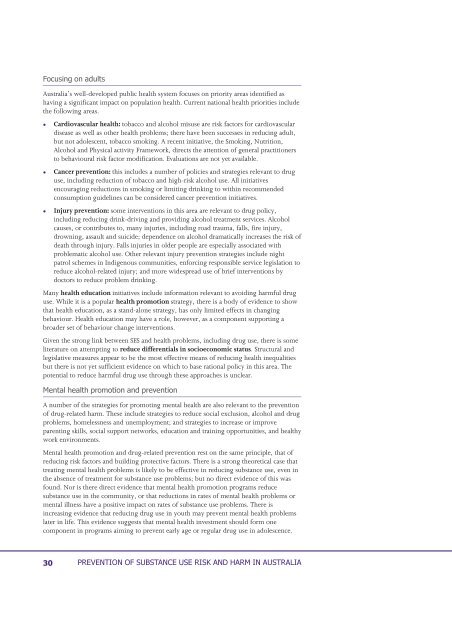Summary - Department of Health and Ageing
Summary - Department of Health and Ageing
Summary - Department of Health and Ageing
You also want an ePaper? Increase the reach of your titles
YUMPU automatically turns print PDFs into web optimized ePapers that Google loves.
Australia’s well-developed public health system focuses on priority areas identified as<br />
having a significant impact on population health. Current national health priorities include<br />
the following areas.<br />
<br />
<br />
Cardiovascular health: tobacco <strong>and</strong> alcohol misuse are risk factors for cardiovascular<br />
disease as well as other health problems; there have been successes in reducing adult,<br />
but not adolescent, tobacco smoking. A recent initiative, the Smoking, Nutrition,<br />
Alcohol <strong>and</strong> Physical activity Framework, directs the attention <strong>of</strong> general practitioners<br />
to behavioural risk factor modification. Evaluations are not yet available.<br />
Cancer prevention: this includes a number <strong>of</strong> policies <strong>and</strong> strategies relevant to drug<br />
use, including reduction <strong>of</strong> tobacco <strong>and</strong> high-risk alcohol use. All initiatives<br />
encouraging reductions in smoking or limiting drinking to within recommended<br />
consumption guidelines can be considered cancer prevention initiatives.<br />
Injury prevention: some interventions in this area are relevant to drug policy,<br />
including reducing drink-driving <strong>and</strong> providing alcohol treatment services. Alcohol<br />
causes, or contributes to, many injuries, including road trauma, falls, fire injury,<br />
drowning, assault <strong>and</strong> suicide; dependence on alcohol dramatically increases the risk <strong>of</strong><br />
death through injury. Falls injuries in older people are especially associated with<br />
problematic alcohol use. Other relevant injury prevention strategies include night<br />
patrol schemes in Indigenous communities, enforcing responsible service legislation to<br />
reduce alcohol-related injury; <strong>and</strong> more widespread use <strong>of</strong> brief interventions by<br />
doctors to reduce problem drinking.<br />
Many health education initiatives include information relevant to avoiding harmful drug<br />
use. While it is a popular health promotion strategy, there is a body <strong>of</strong> evidence to show<br />
that health education, as a st<strong>and</strong>-alone strategy, has only limited effects in changing<br />
behaviour. <strong>Health</strong> education may have a role, however, as a component supporting a<br />
broader set <strong>of</strong> behaviour change interventions.<br />
Given the strong link between SES <strong>and</strong> health problems, including drug use, there is some<br />
literature on attempting to reduce differentials in socioeconomic status. Structural <strong>and</strong><br />
legislative measures appear to be the most effective means <strong>of</strong> reducing health inequalities<br />
but there is not yet sufficient evidence on which to base rational policy in this area. The<br />
potential to reduce harmful drug use through these approaches is unclear.<br />
<br />
A number <strong>of</strong> the strategies for promoting mental health are also relevant to the prevention<br />
<strong>of</strong> drug-related harm. These include strategies to reduce social exclusion, alcohol <strong>and</strong> drug<br />
problems, homelessness <strong>and</strong> unemployment; <strong>and</strong> strategies to increase or improve<br />
parenting skills, social support networks, education <strong>and</strong> training opportunities, <strong>and</strong> healthy<br />
work environments.<br />
Mental health promotion <strong>and</strong> drug-related prevention rest on the same principle, that <strong>of</strong><br />
reducing risk factors <strong>and</strong> building protective factors. There is a strong theoretical case that<br />
treating mental health problems is likely to be effective in reducing substance use, even in<br />
the absence <strong>of</strong> treatment for substance use problems; but no direct evidence <strong>of</strong> this was<br />
found. Nor is there direct evidence that mental health promotion programs reduce<br />
substance use in the community, or that reductions in rates <strong>of</strong> mental health problems or<br />
mental illness have a positive impact on rates <strong>of</strong> substance use problems. There is<br />
increasing evidence that reducing drug use in youth may prevent mental health problems<br />
later in life. This evidence suggests that mental health investment should form one<br />
component in programs aiming to prevent early age or regular drug use in adolescence.

















